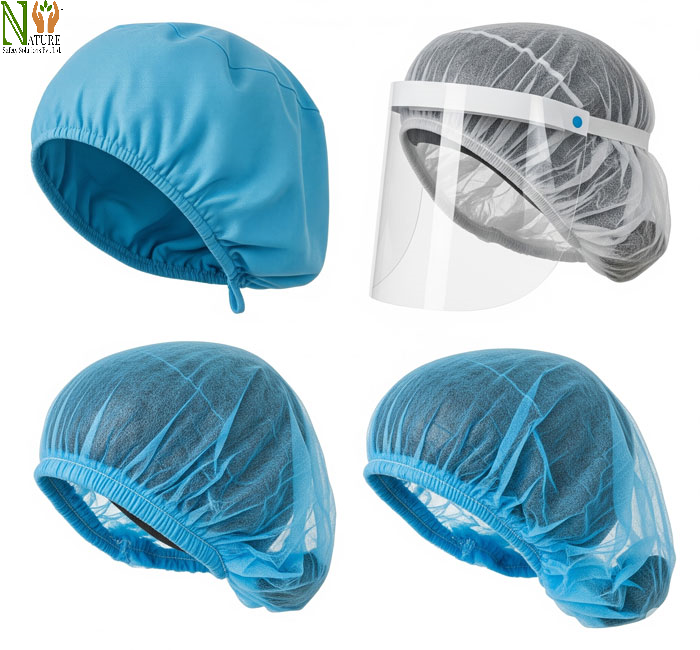When it comes to personal protective equipment (PPE), most of us immediately think about face masks, gloves, or gowns. However, one small yet essential item often goes unnoticed — the PPE head cover.
Despite its simple appearance, this protective gear plays a critical role in maintaining hygiene, ensuring safety, and preventing contamination in many industries.
From busy hospitals and research labs to food factories and cleanrooms, PPE head covers are a silent but powerful part of workplace safety.

What Is a PPE Head Cover?
A PPE head cover is a specially designed piece of protective gear meant to cover the scalp, hair, and sometimes even the neck and shoulders.
Its main function is to prevent hair and other particles from contaminating the environment while protecting the wearer from external hazards like dust, chemicals, and microorganisms.
These head covers are usually made from materials like non-woven fabric, polypropylene, or polyester, which are lightweight, breathable, and comfortable to wear for long periods.
Depending on the need, some head covers are disposable while others are made from reusable fabric, which can be washed and worn again.
Why Are PPE Head Covers Important?
Hair is a natural carrier of dust, dirt, and microbes. Even in the cleanest environments, it can shed and contaminate surfaces or products. In hospitals, this can increase the risk of infections for patients.
In food processing, it can lead to unsafe and unhygienic products. For these reasons, industries that require strict hygiene standards mandate the use of PPE head covers.
Moreover, in industrial or laboratory settings, workers may be exposed to harmful substances such as chemical splashes, dust particles, or toxic fumes. A PPE head cover acts as a barrier, offering additional protection for the scalp and hair.
Another key reason for using head covers is compliance with safety regulations. Organizations such as OSHA and WHO recommend or require PPE, including head protection, in sensitive work environments.
Where Are PPE Head Covers Used?
PPE head covers are widely used in:
- Healthcare settings: Hospitals, operating rooms, and pharmaceutical facilities rely on head covers to maintain sterile conditions during surgeries and procedures.
- Food and beverage industries: Restaurants, bakeries, and food factories require employees to wear head covers to prevent contamination of food products.
- Research laboratories: Scientists and lab technicians use head covers to avoid contaminating sensitive experiments or exposing themselves to hazardous materials.
- Cleanrooms and electronics manufacturing: Even the smallest particles can damage delicate products like semiconductors. Head covers help maintain a dust-free environment.
- Industrial workplaces: Workers in construction, mining, or chemical plants use head covers to protect themselves from dust, dirt, or harmful substances.
Types of PPE Head Covers
While all head covers serve the same basic purpose, their designs vary depending on the level of protection needed.
- Bouffant Caps: These are loose-fitting, dome-shaped caps that completely enclose the hair. They are lightweight, disposable, and commonly used in hospitals, salons, and food factories.
- Surgeon Caps: These are snug-fitting and designed to stay securely in place during medical procedures. Surgeons and nurses wear these caps to maintain sterile conditions in operating rooms.
- Full Hood Covers: These provide extended protection, covering the head, neck, and sometimes the shoulders. They are ideal for high-risk environments such as laboratories or areas with chemical exposure.
- Reusable Fabric Caps: Made from materials like cotton or polyester, these are washable and suitable for industries where contamination risks are lower but hygiene is still essential.
- Industrial Head Covers: These are made with thicker, sometimes chemical-resistant materials to withstand tough environments in construction or manufacturing.
Benefits of Using a PPE Head Cover
The advantages of using a PPE head cover extend beyond just hygiene. For healthcare professionals, they play a vital role in infection control, reducing the risk of transmitting bacteria or viruses. In the food industry, they help companies meet safety standards and avoid health hazards.
Head covers are also designed for comfort. The lightweight and breathable materials prevent heat buildup and allow workers to wear them for extended periods without discomfort. Disposable options make it easy to maintain cleanliness, while reusable ones are cost-effective and environmentally friendly.
Another benefit is their role in promoting professionalism. A worker wearing a clean, well-fitted head cover gives a strong impression of care, attention to hygiene, and adherence to safety protocols.
Also read :-
